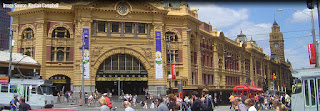Ride with me
By Sean Hua
Car drivers are apparently significantly more stressed on
their commute than those that use other means of transport, as observed in this
study in Montreal. Having to budget more time for their commute and the unpleasantness of the journey contributed to unhappy commuters. Have drivers
have been conditioned to believe driving is the best way to get to work, and more importantly, do they have no other choice but to get to work by
car? Would commuting drivers switch to
public transport if they had better access to it?
Another
study in Denver, Colorado, looked at the travel patterns of commuters, to
see what impact accessibility to a station played on a person’s desire to use
public transport. They assessed whether home or a workplace’s proximity to a
station provided bigger impetus to use public transport. The results indicated three
significant conclusions:
- People are more likely than average to take public transport to work, if only their workplace was close to a station.
- People are more likely than average to drive if their workplace was far from a station, even if they have a station close to home.
- People are much more likely to take public transport if both ends of their commute are close to stations.
In Melbourne, both the road and rail networks appear to
be near capacity. Frequent jams on the freeways and packed trains on the
morning commute are symptomatic of this. Simultaneously, the polls during the
recent leadership spill indicate the general public consensus is for Australia
to act more on climate change. One important means to do so would be to use
more efficient sustainable mass transport than a private car and its associated
road infrastructure. The proposed Melbourne Metro Rail Project could be a step
in the right direction, even if completion will be far into the future. Why?
Read on.
This body of research suggests that the better penetration
of the Melbourne CBD and inner suburbs by the Melbourne Metro Rail Project could significantly increase ridership. This is due to the CBD and the inner suburbs
being areas with a high concentration of businesses, significantly higher than the middle and outer suburbs which are predominantly residential. As the evidence suggests,
proximity to workplaces are a greater attractor for transit use than closeness
to home.
However, increased connections around the CBD only focus on
one end of the commute journey. Simultaneous residential development close to
the stations and activity centres would allow both ends of a commute trip to be
attractors. If the uptake of public transport occurs faster than the growth of
population, it stands to reason that roads themselves would be more free of
congestion, and that emissions would be reduced.
Both hard and soft incentives should be deployed to keep the
now-excess road space from inducing driving demand and to promote public
transport. With cleaner air, less noise, less stress and less lost-time, what
more could you want?
Of course, combating climate change has many more facets
than just switching from cars to trains, but for this at least… I’m all for it.
Just one question though: if and when this change occurs, what do we do with
all the roads?
To read more please see here.
For the studies, please see here and here. Please note, you will need to purchase the studies to view them.
For the studies, please see here and here. Please note, you will need to purchase the studies to view them.



Comments
Post a Comment